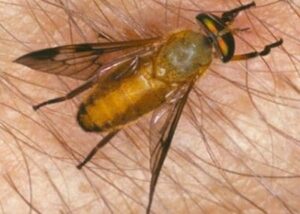DON’T LET FLIES KEEP BOTHERING YOU. LET US HELP.
We’ll identify the types of flies infesting your home and property and provide the best solution.
PEST CONTROL LIBRARY
Flies
There are more than 110,000 different kinds of flies in the world today. Some, like filth flies, can carry plenty of dangerous diseases (such as dysentery, typhoid fever, anthrax, conjunctivitis, yaws, and more) while others—such as yellow flies—can have pretty unpleasant bites and after-effects. This article will help you to identify the species by sharing specifics about some of the most common types of flies in our state.
(We recognize how it may be hard to pinpoint the details of ones zipping around the house. Quarter inch or half inch in length? Where, exactly, are the spots of color on their wings?)
If you’re experiencing problems with this pest, Turner Pest Control may be the best route to rid your Florida home of them. Our experienced team can identify the species and, more important for your family, get rid of them for you.
This is a broad category of flies, with more than 1,700 types in the world and 255 species that live in North America. The various species of this small biting pest that live in North America, fortunately, aren’t disease-spreading ones but they can be quite annoying, nevertheless. In fact, their bites can hurt, cause itching, swelling, and bleeding—and, in some cases, numbness and/or infection. Only female black flies feed on blood and only during the day. Males feed mainly on nectar.
As the name already tells you, these flies are dark in hue, up to about half an inch in size (although many of them are smaller). A distinctive feature: their wings, which are large for their body size and are in the shape of a fan. They know just how to attack the vulnerable spots on people and animals, including their ears, eyes, and scalps. They sometimes also feed on exposed arms and legs or crawl into clothing to get to their source of food.
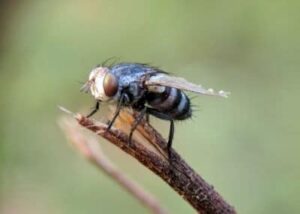
You might hear this species referred to as the common blue bottle fly or the green bottle fly. They’re somewhat larger than typical house flies (more about them later in this post), measuring about half an inch in length. As these pests are buzzing around your home, it may be hard to distinguish between a house fly that’s a quarter of an inch and a blow fly that’s half an inch. Fortunately, there’s an easier way to identify them: by their iridescent colors, a metallic blue, green, copper or black. Like the house flies, they have tiny hairs on their body but those micro-hairs aren’t easily seen.
Although their wings are clear, they feature veins that have a brownish hue. Like the house fly, their eyes are red, and their legs and antennae are black.
It may be easier to identify them by where they hang out: around garbage, manure, animal waste, and dead animals. So, if you see a fly infestation around a trash can, there’s a reasonably good chance they’re blow flies/bottle flies.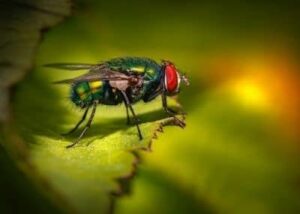
There are different kinds of flies within this species with the ordinary house fly the most common type. House flies, like the other species, are relatively small in size but can be pretty big in peskiness. As an adult, they reach between ⅛” to ¼” in length with females being larger than their male counterparts. They are typically gray in color, with reddish-eyes, sponging mouthparts and having four narrow black stripes between their necks and abdomen (their “thorax”). The house fly’s feeding and breeding habits, along with its persistence for invading homes and feeding on human food, enable the house fly to spread intestinal diseases such as dysentery and diarrhea.
Other common small filth flies we most commonly see in our Florida/Southern region are the Fruit Fly (red or dark-eyed), Drain (Moth) Fly, Phorid (Humpback) Fly and Fungus Gnat.
Fruit flies are small pests that are commonly found in homes, restaurants, and other facilities where food is processed. They are found on decaying matter, especially fruits and vegetables, that have been stationary for several days. These small oval-shaped flies are tan in color and a potential health concern, especially when present in health facilities.
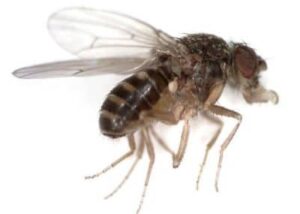
The Drain or Moth fly have short hairy bodies and dark wings which resemble those of a moth. They have long antennae, wings that are leaf shaped and when at rest, they are held roof like over their body. These flies breed in decomposing organic material, such as moist plant litter, garbage, sewage, and around kitchen or bathroom sinks where there is standing water.
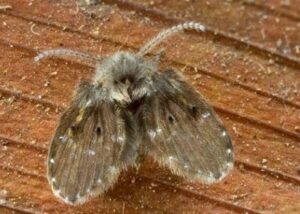
Phorid flies are also referred to as Humpbacked flies because their small head and arched thorax gives them a humpbacked appearance. Most are black or dull brown but some are yellowish in color. These flies are often mistaken for gnats because they are very small – between 1/64” to 1/1” in length. Adult phorid flies have a peculiar habit of rapidly running across windows, TV screens, tables, walls and plan foliage. They feed on many types of substances but develop in moist areas where organic material and standing water are present.
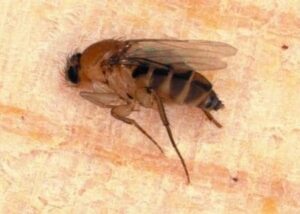
The Fungus Gnat is about 1/8” to 1/10” long, grayish to black, slender, mosquito-like, with long legs, antennae and one pair of wings. They can be identified by the vein patterns in the wings which are Y shaped and adults have eyes that meet above the base of the antennae. These gnats become a nuisance pest indoors when adults emerge in large numbers from potted plants with over-watering or poor drainage systems create ideal breeding sits of fungus gnats. They can also survive indoors in damp, new construction materials and in areas near leaky roofs or water pipes.
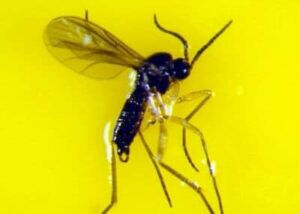
This species has been called one of the fiercest flies in the world (referring to females). They look similar to deer flies, thanks to their yellow bodies (growing up to about half an inch) that have black stripes and yellow fur. One way to tell them apart: yellow flies have black, brown, and tan coloration near the wings’ top while deer flies have tan to brown hues near the wings’ middle. Front legs are black; the other two pairs have a yellow-gray cast. Eyes are a bright blue-green with two bands of purple.
Although males don’t bite, female bites are painful and itchy. In some cases, the area will swell up and may be prone to infection. The females will bite throughout the day but are most active during late afternoon and on cloudy days. They are common near water but then to stay in or near woods. Peak season for yellow flies in Florida is April – June but they are seen through November.
